


The model solves for turbulence intermittency (fluctuations) only, so the transport equation for transition momentum thickness Reynolds number is avoided. Gamma transition – which is a one-equation model, and it is the easiest to use.There are three transition models in Simcenter STAR-CCM+ : For example, if you have separation induced transition the separation bubble cannot be captured with turbulence models only, a transition model is therefore needed. It is therefore important to model transition to get the correct results. But if you are looking at lift/drag for example, transition effects can affect the flow field to a large extent. For many applications the transition is not worth modelling since it is not the driving phenomenon in your system. Transition modelling is of importance when the transition is included in the physics you want to simulate. Modelling of transition in Simcenter STAR-CCM+ Separation induced transition – When you have laminar separation, and the flow reattaches in the turbulent boundary layer, for example when a separation bubble occurs on an airfoil with laminar flow.Fluctuations (turbulence) in the free stream outside of the boundary layer counts as external in this case.

Bypass transition – When external disturbances cause a sudden transition from laminar to turbulent.Natural transition – When the flow is gradually transitioning from laminar to turbulent, with small fluctuations introduced in the flow due to that turbulence is induced.Transition flow is when the flow goes from laminar to turbulent. Here we have collect ed the information that is available on Support C enter and in the documentation into one document, together with some tips, which hopefully will help you in your transition flow simulations. In this week’s blog post we are looking into transition modelling.


 0 kommentar(er)
0 kommentar(er)
